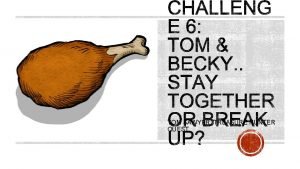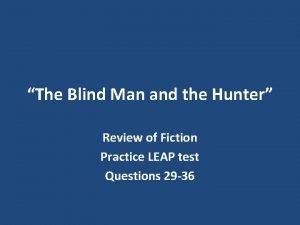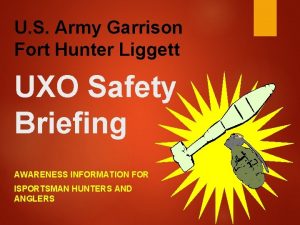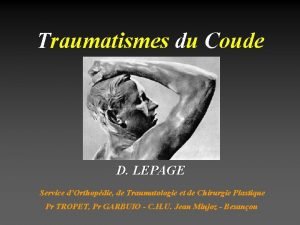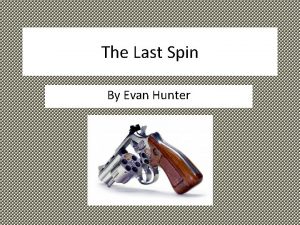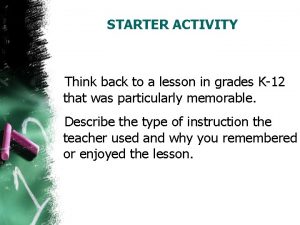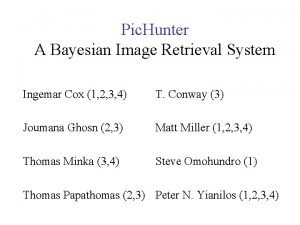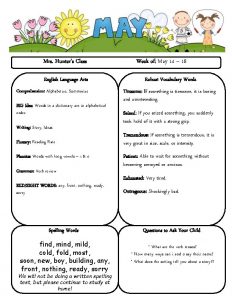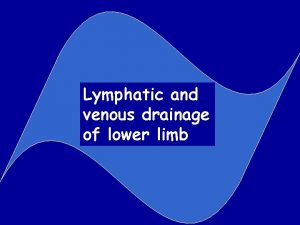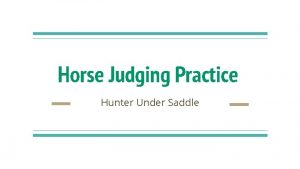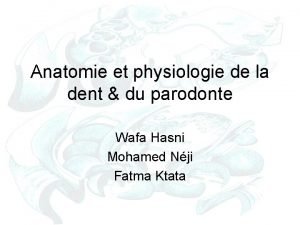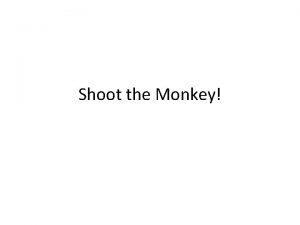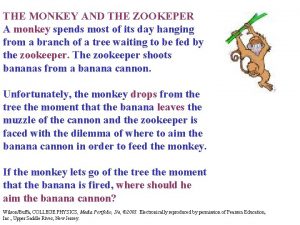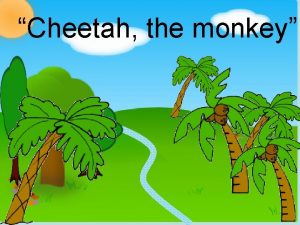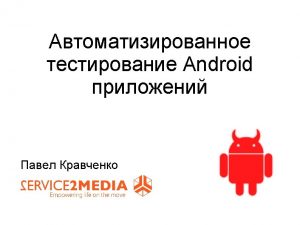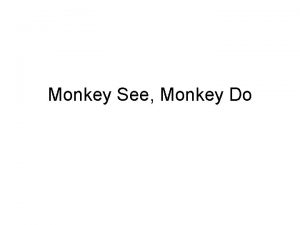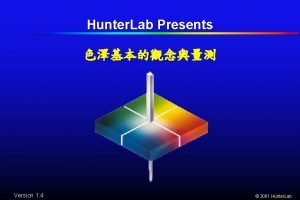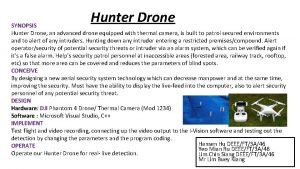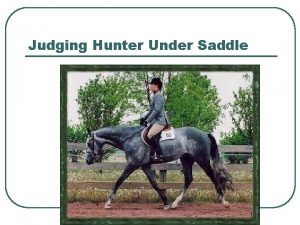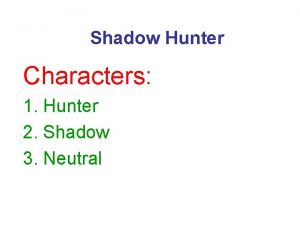The monkey and the hunter The monkey will



























- Slides: 27

The monkey and the hunter The monkey will drop out of the tree the moment the gun is fired. Where should the hunter aim? No matter what the angle, speed of bullet or distance between the monkey and hunter, he should aim at the monkey http: //www. youtube. com/watch? v =cxvs. HNRXLjw&feature=related By considering the horizontal & vertical components of the motion of the bullet and the monkey, you can prove that the two always collide. Vectors are used to model the motion of particles in 2 or even 3 dimensions and enable you to understand situations like this

What is a vector? A vector describes the direction and length of a movement You have already met column vectors when describing shape translations 6 left, 1 down E Vectors can also be represented by a single letter in bold or by the letters at the start and finish with an arrow above them Eg PQRS is a parallelogram P D Q 0 left/right, 5 up F Eg Write down the vector needed to translate from: F to E E to D S R

Q Eg PQRS is a parallelogram. Find vectors for: R a X a) P b) c) S b where X is the midpoint of QS d) Y is the point on the line RS such that 2 RY = SY Find vectors for: Q a e) f) g) R P X b Y S Now do Ex 6 B

Cartesian vectors Eg In M 1 you use vectors given in i, j notation, where i is the horizontal component (‘due East’) and j Is the vertical component (‘due North’) Eg Vectors given in this form can be added or subtracted by treating the i and j components separately Eg Eg Now do Ex 6 C

Magnitude and direction of Cartesian vectors You can use Pythagoras to find the magnitude or modulus of a Cartesian vector Eg the vector You can use trigonometry to find the angle of a Cartesian vector Eg find the angle between the vector and the vector i N Eg find the bearing of the vector θ Bearing = 90 - θ Now do Ex 6 D

Find the magnitude and bearing of these vectors: N i) θ N iii) θ

Find the magnitude and bearing of these vectors: i) iii)

Position vectors You have already seen that, for a particle moving with constant speed, Using Cartesian vectors, if a particle has initial position vector and velocity v Eg A particle starts from the point with position vector (3 i + 7 j) m and moves with constant velocity (2 i - j) m s– 1. a) Find its position after t seconds Cartesian vectors can be manipulated by treating the i and j components separately b) Its position vector after 3 seconds c) The time when its position vector is 25 i – 4 j Equating i - component Equating j - component

Eg At time t = 0, a particle has position vector (4 i + 5 j). The particle moves horizontally with constant velocity (-3 i + 2 j) m s– 1. a) Find the distance travelled after 5 seconds Distance travelled when t = 5 The point Q has position vector (6 i + 13 j) m. b) Find the time when the particle is due west of Q. Position vector of particle: Particle is due west when j components are the same NB: another approach to (b) is to find then find when the j component is zero Now do Ex 6 F, Q 9 -12

Ex 6 F, Q 11 a) b) c) i-components equal when j-components equal when Therefore no time when i and j components are equal – they wont collide d)

Velocity vectors If a particle is accelerating then its velocity can described as a vector using Eg A particle P moves in a horizontal plane. The acceleration of P is (4 i - 2 j) m s– 2. At time t = 0, the velocity of P is (i + j) m s– 1. At time t seconds, the velocity of P is v m s– 1. Find (a) an expression for v in terms of t, in the form ai + bj, (b) Find the velocity of P when t = 5, Eg A particle moving with constant velocity has position vector (2 i - 4 j) m when t = 0. Five seconds later it has position vector (12 i + 16 j) m Find the velocity and speed of the particle. If velocity Speed

Eg A particle P moves in a horizontal plane. The acceleration of P is (3 i + 5 j) m s– 2. At time t = 0, the velocity of P is (-5 i – 4 j) m s– 1. When is P moving parallel to j? Parallel to vector j => i-component = zero When is P moving parallel to i? Parallel to vector i => j-component = zero Now do Ex 6 H, Q 4 & 8

Ex 6 H, Q 4 Parallel to vector i => j-component = zero Angle = 180 - θ θ Ex 6 H, Q 8 Angle = 180 - θ θ

WB 9 A particle P moves with constant acceleration (2 i – 3 j) m s-2. At time t seconds, its velocity is v m s-1. When t = 0, v = -2 i + 7 j. (a) Find the value of t when P is moving parallel to the vector i. Parallel to vector i => j-component = zero (b) Find the speed of P when t = 3. (c) Find the angle between the vector j and the direction of motion of P when t = 3. Angle = 180 - θ θ

Problem solving Eg At time t = 0, a football player kicks a ball from the point A with position vector (2 i + j) m on a horizontal football field. The motion of the ball is modelled as that of a particle moving horizontally with constant velocity (5 i + 8 j) m s– 1. (a) Find the speed of the ball, (b) the position vector of the ball after t seconds. The point B on the field has position vector (10 i + 7 j) m. (c) Find the time when the ball is due north of B. Ball is due North when i components are the same (d) At time t = 0, another player starts running due north from B and moves with constant speed v m s– 1. Given that he intercepts the ball, find the value of v. 2 nd player starts at So 2 nd player has to run 6. 8 m in 1. 6 s (e) State one physical factor, other than air resistance, which would be needed in a refinement of the model of the ball’s motion to make the model more realistic. Friction of the ball against the playing field

Eg A particle P moves in a horizontal plane. The acceleration of P is (–i + 2 j) m s– 2. At time t = 0, the velocity of P is (2 i – 3 j) m s– 1. (a) Find, to the nearest degree, the angle between the vector j and the direction of motion of P when t = 0. θ Angle = 90 + θ At time t seconds, the velocity of P is v m s– 1. Find (b) an expression for v in terms of t, in the form ai + bj, (c) the speed of P when t = 3, (d) the time when P is moving parallel to i Parallel to vector i => j-component = zero

WB 7 A coastguard station O monitors the movements of ships in a channel. At noon, the station’s radar records two ships moving with constant speed. Ship A is at the point with position vector (– 5 i + 10 j) km relative to O and has velocity (2 i + 2 j) km h– 1. Ship B is at the point with position vector (3 i + 4 j) km and has velocity (– 2 i + 5 j) km h– 1. (a) Given that the two ships maintain these velocities, show that they collide. i-components equal when Two particles A and B will collide if there is a value of t for which giving The coast guard radios ship A and orders it to reduce its speed to move with velocity (i + j) km h– 1. Given that A obeys this order and maintains this new constant velocity, (b) find an expression for the vector at time t hours after noon.

(c) find, to 3 significant figures, the distance between A and B at 1400 hours, Distance between A and B (d) find the time at which B will be due north of A. Due north => i-component = zero

WB 8 Two boats A and B are moving with constant velocities. Boat A moves with velocity 9 j km h– 1. Boat B moves with velocity (3 i + 5 j) km h– 1. (a) Find the bearing on which B is moving. At noon, A is at point O, and B is 10 km due west of O. At time t hours after noon, the position vectors of A and B relative to O are a km and b km respectively. (b) Find expressions for a and b in terms of t, giving your answer in the form pi + qj. (c) Find the time when B is due south of A. Due south => i-component = zero Bearing = θ

At time t hours after noon, the distance between A and B is d km. By finding an expression for , (d) show that At noon, the boats are 10 km apart. (e) Find the time after noon at which the boats are again 10 km apart. Now do Ex 6 H, Q 6, 7, 9, 10

Bearing = 90 - θ Ex 6 H, Q 6 θ Due East => j-components equal

Ex 6 H, Q 7 θ Bearing = 180 - θ S travels in 40 minutes Given that when , Equating i components M has travelled 20. 5 i in ½ hour Equating j components M has travelled -11. 5 j in ½ hour

Ex 6 H, Q 9 Due North => i-components equal Player must run (60. 5 – 12) m in 6. 5 s

Ex 6 H, Q 10 Given solution Find other factor

The monkey and the hunter Bullet’s position Monkey’s position Sub in Therefore when the two will collide (regardless of angle, distance or velocity)

Rolling wheel What path will the point follow as you watch the wheel roll from side-on? The locus of the point on the wheel is called a cycloid Using vectors, the exact trajectory of this point can be easily understood Vectors are crucial to understanding the motion & forces acting on objects around us

 Monkey see monkey do monkey connect
Monkey see monkey do monkey connect Joe hunter treasure hunter
Joe hunter treasure hunter Old world monkey vs new world monkey
Old world monkey vs new world monkey Kinetic letters whiteboard
Kinetic letters whiteboard Kinetic letters font download
Kinetic letters font download The blind man and the hunter
The blind man and the hunter Compare and contrast the monkey's paw and the third wish
Compare and contrast the monkey's paw and the third wish The monkey s paw characters
The monkey s paw characters Al hunter safety
Al hunter safety Uxo report
Uxo report Ligne de hunter et triangle de nelaton
Ligne de hunter et triangle de nelaton The last spin by evan hunter
The last spin by evan hunter Systematic instruction: hunter model
Systematic instruction: hunter model Junior score
Junior score Hunter's curve
Hunter's curve Pic hunter
Pic hunter Mrs hunter day
Mrs hunter day Hunter perforator
Hunter perforator Cocketts perforators
Cocketts perforators What group is a primary supporter of hunter education
What group is a primary supporter of hunter education Hunter maclean
Hunter maclean Papillomavorus
Papillomavorus Hunter under saddle judging
Hunter under saddle judging Dark fiber backhaul
Dark fiber backhaul Hunter shively
Hunter shively David hunter antropologi
David hunter antropologi Lame cribriforme dent
Lame cribriforme dent Hunter commission
Hunter commission

